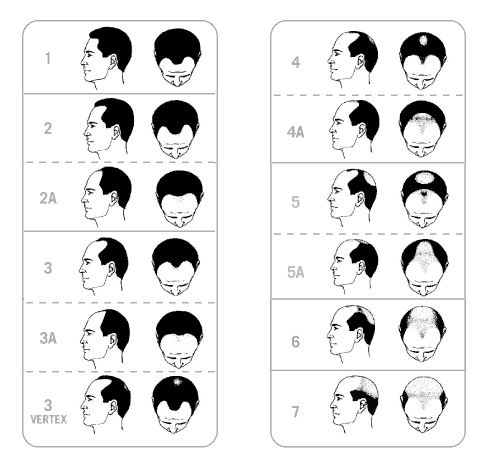The Hair Transplant Procedure Hair transplantation is a surgical procedure where by a strip of hair-bearing skin is removed from the side or back of the scalp and then subdivided into small pieces to make follicular units. The follicular units are then transplanted into the balding recipient area.
Hair transplantation
is based on the principal of “donor dominance ”. Hair is transferred from one location to another on the same person. It survives, grows and attains the same characteristics that it had in the original site. The hair in the back and on sides of the scalp is the preferential site for donor hair because it will grow for the rest of your life.
Transplanted hair assumes the characteristics of the donor area and can be dyed, washed and styled as you wish.
Candidates
Hair transplants offer a permanent solution for baldness. Although they have been mostly performed on patients with male pattern baldness (MPB); the “M” shaped recession of hair which is common in men, hair transplants are also performed for baldness caused by scars resulting from burns, accidents, facelifts, radiation treatments, operations and certain diseases. Also, they are used to treat women with female pattern baldness (FPB). In fact, ~20% of our patients are females.
Hair transplants can be performed on people of all ages. The main criterion that are important for a successful hair transplant is the availability of a good donor area and the patient’s state of health. The physician should be made aware of any history of heart attacks, anemia, bleeding abnormalities, ingestion of vitamins, aspirin or blood-thinners, epilepsy, drug reactions, allergies or a tendency to form scars or keloids.
Evaluation
The 1st visit to the doctor is considered as an evaluation session. At this time, the patient is assessed as being a good, fair, or poor candidate for a hair transplant. The number of required follicular units is determined by measuring the density and diameter through a microscope. This assessment cannot be done over the internet. The amount of hair transplantation sessions depends on the size of the bald recipient area and the desired density.
The Procedure
The placement of the hairline is crucial. Dr. Kohn
uses his experience and expertise in conjunction with the patients' desires to draw a hairline that will be appropriate for the patient now and for the rest of his life. The hairline is not supposed to be a line. It is a transition zone between the bald forehead and the hairbreaing skin of the scalp.
During the procedure which is safely done in a dedicated surgical suite in the doctors office, the donor area is anesthitized with a local anesthetic, the patient is totally awake at all times. The donor hair is then harvested and the resultant defect is sutured in order to create an essentially invisible scar. It is then subdivided into follicular units. Small incisions are made with a needle in the recipient area. The depth of the incision is directly related to the depth of the root.
In order to provide our patients with the most comfort our team features the buddy system of graft placement. Four staff members work together in graft placement in order to expediate the procedure and provide our patients with the best possible results.
Approximately 12 weeks later, new hair begins to grow at the normal rate of approximately ½ inch per month. Usually, 12 weeks are required between sessions to assure adequate visualization of the previous transplanted area. Each session takes 3-4 hours, including the preparation, the procedure, and the post-operative care. Any discomfort that may occur is mild and generally relieved with Atasol or Tylenol.
After the procedure, the patient is given a post-hair transplant instruction sheet. For those patients who find it difficult to wash their own hair at home we offer this service the day after the hair transplant at our office at no additional charge.
Scalp Reduction
Scalp reductions are sometimes performed in the crown area in addition to hair transplantation. In this procedure, a bald portion of scalp is surgically excised then the adjacent hair-bearing scalp
is pulled together and sutured to cover the area, thus replacing the bald area with hair-bearing skin. It is especially helpful for patients who have rather extensive hairloss because it allows optimal use of the limited donor areas.
Cost The fee for a hair transplant is based upon the number of follicular units transplanted and the size of the bald area. It is best to discuss the estimated cost with your physician at the time of your initial evaluation. All fees are in Canadian dollars. Our hair transplant fees are generally competitive. If you take into consideration the extraordinary time, precision, and attention to detail that we provide, there is simply no better value. There are no extra charges for follow-up visits related to your hair transplant. A 50% deposit is requested 2 weeks prior to the procedure date, and the balance of payment is due on the day of the procedure. C.T.C. International Inc. accepts all major credit cards, interact payments, and financing can be arranged.
Insurance coverage exits only for special cases of baldness. For example, loss of hair due to an accident, an operative procedure, or a disease. The cost of this procedure is fully tax deductible. We advise you to consult with your accountant for details.
Hair Loss Type
Male Pattern Baldness

Female Baldness

|




